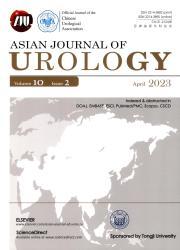体外模型液体流动控制中人工括约肌最佳施加压力和袖口数量的实验评估
IF 2.4
3区 医学
Q2 UROLOGY & NEPHROLOGY
引用次数: 0
摘要
目的探讨非液压袖口设计控制尿漏时应使用的最佳力,并探讨用于控制尿漏的袖口数量与需求力变化的关系。方法采用5只羊膀胱,设计并构建生物力学评价系统。生物力学系统包括膀胱、压力计、膀胱压力调节系统和袖带施加力系统。在本研究中,我们将膀胱内的液体压力从0 cmH2O增加到200 cmH2O (1 cmH2O=0.098 kPa),并在每个点测量并记录袖带施加的防止液体泄漏的力。结果单袖带平均张力为2.81(标准差0.23)N,双袖带平均张力为1.63(标准差0.16)N,压力对称,可有效防止75 ~ 100 cmH2O压力范围内的膀胱液体漏出(p<0.001)。然而,当比较双袖带与单袖带使用的非对称张力所需的施加张力时,结果没有显着差异。此外,使用三个袖带而不是两个并没有产生显著不同的结果。结论采用对称压力的双袖带比相同拉力的单袖带效果更好。虽然在本研究中发现多个不同张力的尿环对控制尿漏没有作用,但我们建议在多个尿环之间交替和旋转施加不同的力可以减少长期的风险,如萎缩和坏死。未来的体内研究建议进一步评估效率。本文章由计算机程序翻译,如有差异,请以英文原文为准。
Experimental evaluation of the optimum applied pressure and number of cuffs for artificial sphincter in fluid flow control in an ex vivo model
Objective
The aim of this study was to find the optimal force that should be applied to control urine leakage using a non-hydraulic cuff design, and to investigate the relationship between the number of cuffs used in urinary control and the change in demand force.
Method
In this study, five sheep bladders were used to design and build a biomechanical evaluation system. The biomechanical system included the bladder, pressure gauge, pressure regulator system of the bladder, and force application system by the cuff. In this study, we increased the fluid pressure inside the bladder from 0 cmH2O to 200 cmH2O (1 cmH2O=0.098 kPa), and at each point, the force applied by the cuff to prevent fluid leakage was measured and recorded.
Results
The study revealed that a mean tensile force of 2.81 (standard deviation 0.23) N for a single cuff and 1.63 (standard deviation 0.16) N for double cuffs with symmetrical pressure effectively prevented bladder fluid leakage in the pressure range from 75 cmH2O to 100 cmH2O (p<0.001). However, there were no significant differences in results when comparing the applied tensile force required by double cuffs with asymmetric tensile force to that of the single cuff use. Furthermore, using three cuffs instead of two did not yield significantly different outcomes.
Conclusion
Using double cuffs with symmetrical pressure had a greater effect compared with a single cuff with the same tensile force. Although multiple cuffs with varying tensile forces were not found to be useful in controlling urine leakage in this study, it is suggested that applying variable forces alternately and rotationally among several cuffs may reduce long-term risks such as atrophy and necrosis. Future in vivo studies are recommended to further evaluate efficiency.
求助全文
通过发布文献求助,成功后即可免费获取论文全文。
去求助
来源期刊

Asian Journal of Urology
UROLOGY & NEPHROLOGY-
CiteScore
4.00
自引率
3.80%
发文量
100
审稿时长
4 weeks
期刊介绍:
Asian Journal of Urology (AJUR), launched in October 2014, is an international peer-reviewed Open Access journal jointly founded by Shanghai Association for Science and Technology (SAST) and Second Military Medical University (SMMU). AJUR aims to build a communication platform for international researchers to effectively share scholarly achievements. It focuses on all specialties of urology both scientifically and clinically, with article types widely covering editorials, opinions, perspectives, reviews and mini-reviews, original articles, cases reports, rapid communications, and letters, etc. Fields of particular interest to the journal including, but not limited to: • Surgical oncology • Endourology • Calculi • Female urology • Erectile dysfunction • Infertility • Pediatric urology • Renal transplantation • Reconstructive surgery • Radiology • Pathology • Neurourology.
 求助内容:
求助内容: 应助结果提醒方式:
应助结果提醒方式:


